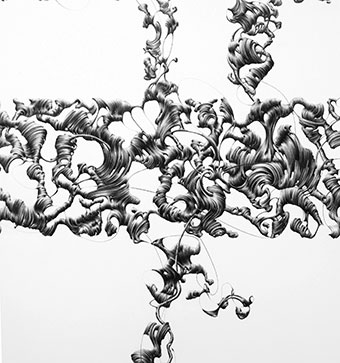Vascular Modes
by Jack Foran



Artists riff on a distinctive piece of medical architecture at Hallwalls
How do 21 different artists make artworks that somehow emulate, somehow pay homage to a distinctive new building that is fast achieving signature status among the downtown medical corridor constructions? The results are on show in the Hallwalls Vascular Modes exhibit.
The artworks are in response to or as comment on the recently completed Gates Vascular Institute building, the design of which somehow emulates, somehow pays homage to the work that will be done there, vascular and neurological care and research, concerning arteries, veins, nerves, the materials and information delivery systems of living bodies.
The building is a box, a cube, but with biological more than strictly construction technological references. Rounded corners, and a series of adventitious horizontal and vertical conduit-like design elements inset into the various façades. Suddenly appearing, traversing a portion of a façade, then disappearing. Like a vein or artery that is visible under skin for a brief extent, then maybe dives into deeper tissue and disappears. The construction is a Cannon Design project, by architect Mehrdad Yazdani.
The most literal vascular systems reference piece is by Michael Bosworth, consisting of two light boxes containing stacks of tubes, apparently, and flexible tubes connecting the boxes, and a red liquid that is alternately pumped and flows by gravity between and through the apparatus. Reference to blood transfusions, dialysis.
Carl Lee has a video in 10 parts that considers the new building in context. The historical context of an East Side area that would have been one of the city’s early residential areas, as the population grew and spread beyond the limits of what is now mid-rise to high-rise downtown. But also the aesthetic context of a novel architectural form situated among a variety of more traditional residential and commercial/medical institutional forms. The architectural form as organism reflecting on the organic nature of the historical development of the area, subject to continued cycles of renewal and decay. In a random montage juxtaposing drawing board conceptuals of the vascular building and images of other area buildings, from handsome orange brick Victorian structures, to infill urban renewal housing looking still vital, to commercial and residential constructions in various phases of lethargic decrepitude. Along with some pristine natural environment images of what the area must have looked something like prior to all the development and redevelopment.
Fotini Galanes’s meticulous pencil drawing piece elaborating a tiny, feathery ornamentation motif is simultaneously effusive and astringent, sophisticated and severe, in a way that recollects the understated baroque quality of the vascular building.
Kate Parzych’s several cyanotypes lean toward more neurological than vein and artery imagery, thin strands of connection amid nerve centers or other focal points of biological significance. What might be a night sky vision, with trace lines of possible constellations added in.
Joan Lindner has a fold-book continuous streetscape depiction of the structures along about a two-mile stretch of the east side of Main Street, from Ferry Street to downtown. And Jody Hanson has a wall sculpture consisting of old medicine bottles held in place by a metal framework that snakes around the matrix backboard like the conduit features on the vascular building.
Phil Hastings has a horror vision synthetic video of what could be a proctologist’s eye view of lubricious tissue complete with orderly array of juicy polyps ripe for harvest, surrounding a pulsating black hole orifice leading to yet unfathomed inner recesses.
Adrian Bertolone has a look at the human/humorous side of vascular care and research. His work is a kind of palimpsest of rough sketch drawings on translucent sheets of human figures that seem to be doctors more than patients. Among scribbled legends like “We’re playing, keep away,” and “Have a heart, we live here. Have a heart, have a laugh.”
Much more to see. Other works by Josef Bajus, Kyle Butler, Scott Bye, Kate Gaudy, Amy Greenan, Lesley Horowitz, Dennis Maher, Mark McLoughlin, Julian Montague, Jan Nagle, Alicia Paolucci, Jean-Michel Reed, and Jason Seeley.
And a video by show curator John Massier, consisting of interviews with the artists that lets them describe in words what they were saying or wanting to say in their artworks.
The Vascular Modes show continues through March 1.
blog comments powered by Disqus|
Issue Navigation> Issue Index > v12n4 (Week of Thursday, January 24) > Vascular Modes This Week's Issue • Artvoice Daily • Artvoice TV • Events Calendar • Classifieds |









 Current Issue
Current Issue